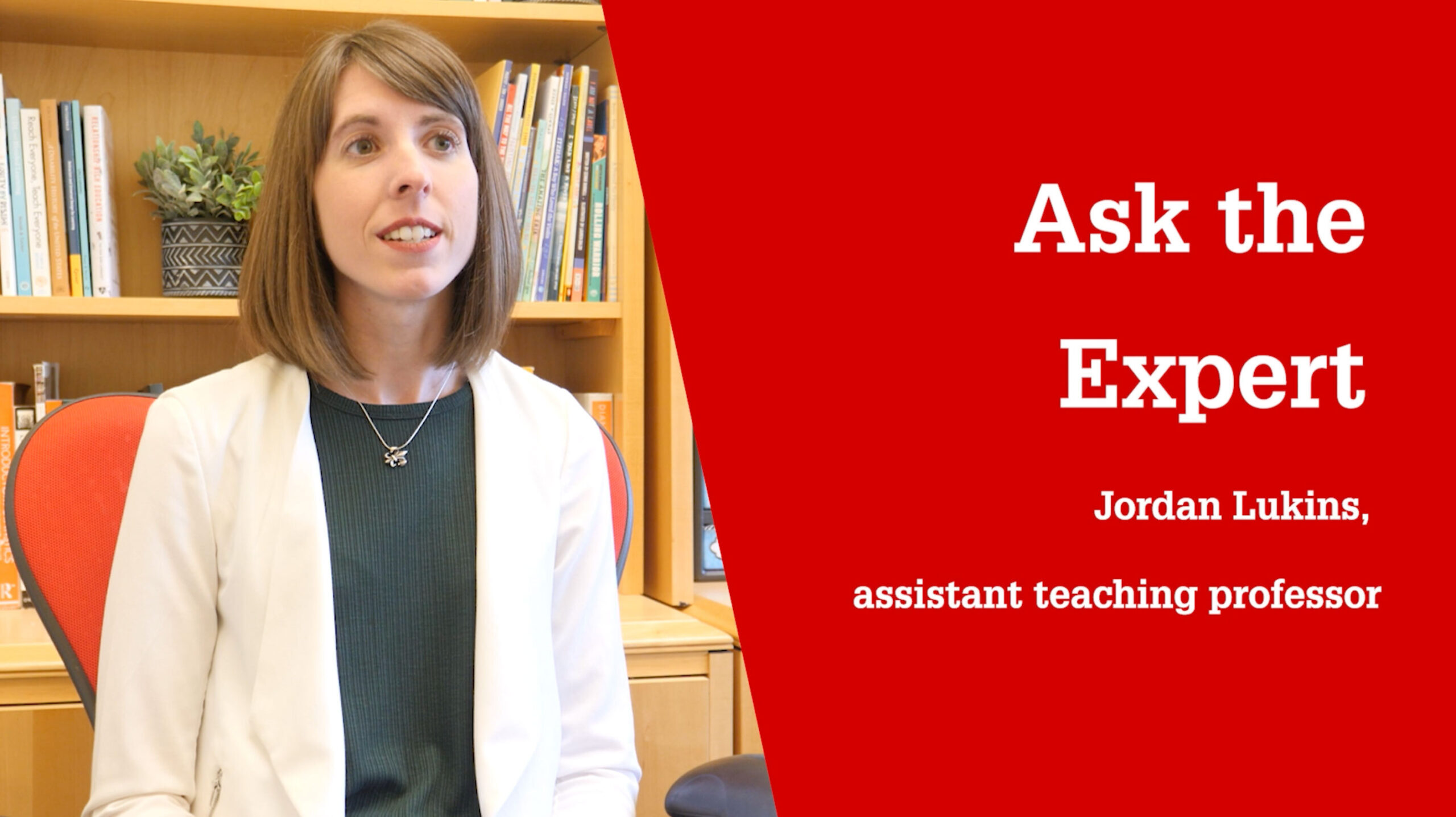How Can Teachers Effectively Lead an Inclusive Elementary School Classroom? Assistant Teaching Professor Jordan Lukins Shares Skills, Tips and Online Resources
About 15% of all K-12 public school students have some type of disability for which they receive special education services. Of those students, two out of three will spend the entire school day, or a majority of their school day, in a general education classroom. For this reason, NC State College of Education Assistant Teaching Professor Jordan Lukins believes that it’s important to bridge the gap between special and general education in schools and when preparing pre-service teachers.
Research, Lukins said, shows that some educators do not feel prepared to teach students with disabilities and that they tend to think about disabilities in a very narrow way. They often think that students receiving special education services are only those with significant physical or cognitive needs who are taught in a self-contained classroom. However, disabilities also include things like ADHD, dyslexia and speech disorders.
“Our society really views disability from this medical idea of a list of characteristics that lead to a diagnosis and maybe a list of strategies or interventions to remediate the difficulties that come along with that. And we see that in our education as well,” said Lukins, whose teaching and research focuses on preparing educators to include and teach students with disabilities. “A lot of teachers report that that’s what they think about special education and disabilities.”
Lukins says it’s important for general education teachers and special education teachers to have a common understanding and common language when it comes to teaching students with disabilities.
“We can’t have special education without working together. General educators, special educators, administrators and families are all expected to work together and implement individualized education programs for our students with disabilities,” she said. “So, we really want to start out in our pre-service programs by equipping future teachers with the skills that they’re going to need to do a collaborative job in the future.”
What Skills Are Important for Inclusive Education?
Each year, Lukins teaches a semester-long class for elementary education students in the College of Education to help them develop the skills they most need to be an effective educator in an inclusive setting.
One of the main things she stresses for her students is the importance of disability etiquette, a term borrowed from the book Demystifying Disability: What to Know, What to Say and How to Be an Ally. The idea of disability etiquette involves thinking about how to show respect to people with disabilities with specific regard for the fact that they are disabled. In an educational setting, this can mean seeing a student as a person beyond their disability, speaking to a student with a disability in the same age-appropriate way you would speak to their peers and always asking permission before touching equipment, such as a wheelchair.
“It’s all of the things you think of when we think about etiquette and respect overall for everyone, but there are some unique kinds of considerations when disability comes into play as well,” Lukins said.
Lukins also encourages her future teachers to adopt the Universal Design for Learning (UDL) framework, which allows them to design lessons and instruction that is accessible to all students from the start. When using UDL, a teacher will develop a lesson with a plan to present information in multiple different formats and consider different modes through which they can communicate content in order to provide students with different ways to engage with a lesson and show what they’ve learned and already know.
“This really sets teachers up for doing less work on the backend, because they’ve done it on the front end and thought ahead about what barriers a student might experience in the classroom, not just because of disability but any array of things that could prevent students from accessing a one-size-fits-all type of instruction,” Lukins said.
In addition to using UDL, Lukins also encourages her students to understand how to intensify their instruction for students who may need extra support, including those with disabilities. Intensifying instruction can take on a variety of different forms including reteaching concepts in small groups, being more explicit in language and defining vocabulary words or providing students with additional strategies or tools like graphic organizers, visual timers or text-to-speech software.
“A lot of times, teachers think that they need to teach something entirely different to a student with disabilities. But, more often than not, the content doesn’t need to change,” Luksin said. “It’s not the ‘what’ of the lesson that needs to change, it’s the ‘how.’”
How Can I Effectively Manage an Inclusive Classroom?
Research shows that many beginning teachers report experiencing troubles with classroom management, and these issues can be amplified when the classroom includes a student whose disabilities might present with significant behavioral challenges.
When managing an inclusive classroom, Lukins has two sayings she typically shares with pre-service teachers:
- “Prevention is the best intervention.” Lukins said teachers can help prevent challenging behaviors from all students by explicitly teaching rules and procedures so students know what behaviors are expected of them in class, building relationships with students and creating a classroom community. It is also important, she said, for teachers to focus on positive reinforcement by offering more praise than correction.
“We talk about a four-to-one ratio; you want to give four positive statements to every one error correction, and that can go a long way in just establishing that preventative, proactive piece,” she said.”
- “All behavior is communication.” When students display challenging behaviors in the classroom, there is usually an underlying cause. Challenging behaviors can occur when a child is tired, hungry or confused, because they don’t understand the directions they were given or because they don’t have the academic skills necessary to access a task. Teachers, Lukins said, can help manage these behaviors by approaching them as an interpreter whose goal is to understand what the behavior is really telling them about a child’s situation.
“When teachers view themselves as that interpreter, they take the time to look at the behavior, collect data on that behavior, figure out what’s triggering it or what’s the payoff in it for the student and then address it at that root rather than just on the surface level,” she said.
Resources for Teaching in Inclusive Classrooms
In her classroom, Lukins is constantly sharing resources with her students in order to help them build a toolbox that will help them effectively lead their own inclusive classroom. For current teachers, she recommends starting with the following resources to learn more about working with students with disabilities:
- Demystifying Disability: What to Know, What to Say and How to Be an Ally: Lukins uses this book with her students, and recommends it for others, because it is written for a lay-audience and introduces ideas about the history surrounding people with disabilities, how to be an ally to people with disabilities and how to practice disability etiquette
- The IRIS Center: Supported by the U.S. Department of Education’s Office of Special Education, the IRIS Center provides free, online training resources for teachers working with students with disabilities and other struggling learners. The website offers self-paced online training modules, tip sheets and case studies related to a wide array of topics including classroom management, instructional strategy tools and collaboration.
- Categories:



